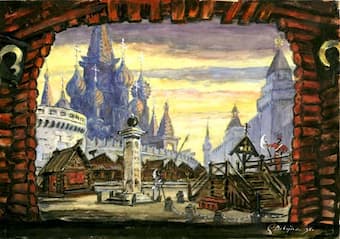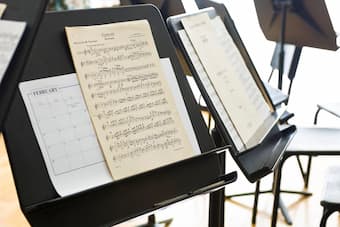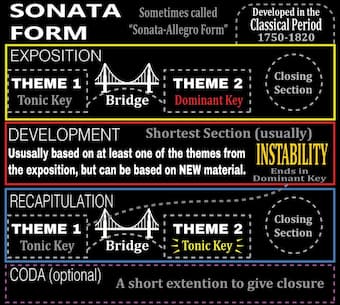Here are some of the world’s most famous classical music melodies and everything you need to know about them.
There’s nothing more annoying than humming a tune but not knowing what it’s called or where it’s from. Fear not – here are some of the most famous tunes from the history of music, complete with all the background information you need.
Read more:
Mozart – Eine kleine Nachtmusik
The official name of this piece is the , and it was composed by in 1787. Mozart himself gave the piece its nickname, when he jotted this name down in the log book he kept detailing all the music he wrote.
The music has been used in Charlie's Angels – Full Throttle, Alien, Ace Ventura and There's Something About Mary, as well as in countless TV programmes and adverts. It also featured prominently in the film Amadeus about the composer himself.
Read more:
Beethoven – Für Elise
This piece was never published during ’s lifetime and it wasn't even discovered until forty years after his death.
As a result, … and some musicologists even think the title might have been copied incorrectly and it was originally called ‘Für Therese’.
But whoever the lucky recipient of this piece was, we can all agree that it’s one of the most charming pieces for piano ever written.
Due to the music’s simple yet catchy melody, there have been countless reinterpretations of the piece including a and a .
Puccini – 'O mio babbino caro' from Gianni Schicchi
O mio babbino caro performed by Susanna HurrellSusanna Hurrell and pianist Jonathan Santagada performs the famous aria from Puccini's Gianni SchicchiThere might be uncontacted tribes in the Amazon who haven't heard this piece, but there can't be many other people in the world who wouldn't recognise this famous aria by .
It comes from his opera , a one-act opera all about the lengths one family will go to to make sure they inherit money from an elderly relative. An unlikely source for a melody that has become famous as one of the most romantic ever writtten…
‘O mio babbino caro’ is performed by young Lauretta, who is pleading with her father to allow her to marry Rinuccio, the man she loves. And it’s fame has far outstripped that of the opera.
It features on the soundtracks for Downton Abbey, Captain Correlli’s Mandolin, A Room with a View, and the list goes on.
J.S. Bach – Toccata and Fugue in D minor
Bach, Toccata and Fugue in D minor - Amy TurkThis piece by might not have the catchiest title, but we guarantee you'll know the famous opening.
It has become associated with scary moments in horror films, perhaps because it famously made an appearance in the opening credits of Dr. Jekyll and Mr. Hyde (1931).
Beethoven – Symphony No.5 in C minor
Beethoven's 5th, conducted by a 3-year-old boyJonathan Okseniuk, an adorable and insanely talented 3-year-old, conducts to the 4th movement of Beethoven's 5th symphony.This symphony by opens with perhaps the four most famous chords of all time – the famous “da da da duuum”. Some critics have suggested that this opening represents the sound of Fate knocking at the door.
Who knows if that's what Beethoven had in mind – but what's beyond a shadow of a doubt is that this piece has come so famous .
Vivaldi – The Four Seasons
Vivaldi's 'Winter' from the Arctic Philharmonic Chamber OrchestraHenning Kraggerud and The Arctic Philharmonic Chamber Orchestra.The Four Seasons is actually a group of four violin concertos by . Each gives a musical expression to a season of the year – listen out for the chattering teeth in Winter, the dramatic storm in summer, and the arrival of the hunt in autumn.
All four of the concertos have become world famous. In fact, you may well have even heard this piece being used as a ringtone!
Bizet – ‘Carmen’
Melodica Men play CarmenBizet's masterpiece as you've never heard it before…'s opera Carmen from 1875 is jam-packed with catchy tunes – from the 'Toreador's Song' to the 'Habanera' and the aria 'L'amour est un oiseau rebelle' to the Overture itself.
Bizet's music has appeared most recently in the Pixar film Sesame Street also did a pretty epic , not to forget Tom and Jerry's .
What many might not know is that Carmen was a pretty groundbreaking opera in the 19th century. Bizet was seen as quite the rebel for having set his music to such a risqué plot. But the opera has gone on to become one of the most successful ever written.
Johann Strauss II – The Blue Danube
The Blue Danube is the commonly used name for 's waltz . The Viennese connections with this song has made it almost an unofficial national anthem for Austria. However, film lovers might recognise it from Stanley Kubrick’s epic film 2001: A Space Odyssey (1968), where it's used in the stunning opening sequence.
Ravel – Boléro
This tune was made famous when it was used by Torvill and Dean for their gold-medal-winning 1984 Olympic performance.
’s music was actually originally composed as a ballet for the Russian dance Ida Rubinstein, so its rise to 20th-century fame through Torvill and Dean’s ice skating routine isn’t far from what the composer intended!
Delibes – ‘Flower Duet’ from Lakmé
Belle Voci Perform 'Flower Duet' On The Voice UK 2018Credit: ITV / The VoiceThe ‘Flower Duet’ is from ’ opera and the composer is a bit of a one-hit wonder. But that one hit has become a super hit – this duet is now one of the most famous ever written. It is traditionally sung by a soprano and mezzo-soprano but its rise to fame has resulted in many different interpretations of the song.
This is by far the most famous section of the opera, and the duet might be best known as the soundtrack to a very memorable British Airways advert.
Grieg – ‘In the Hall of the Mountain King’ from Peer Gynt Suite
Line Rider - In the Hall of the Mountain KingCredit: Doodle Chaos.’s was originally written as incidental music for a production of Ibsen's play Peer Gynt. But he later turned his music into two suites, which have become some of his best known work.
This movement is particularly famous because of its incredibly catchy main theme. Modern pop and rock bands including Electric Light Orchestra, The Who and Savatage have used the melody in their music, and it has also been used for many years by the British theme park Alton Towers as a sort of theme tune, appearing in their adverts and on their YouTube videos.
Mozart – Overture from The Marriage of Figaro
The melodies in this opera overture have been used time and time again in films, TV shows, adverts and even pop music. In the 1971 film Willy Wonka and the Chocolate Factory you’ll hear Willy Wonka opening the doors to his chocolate factory by playing the music from this overture on a miniature piano.
tells the story of Figaro and Susanna, who work for the Count and Countess Almaviva, and whose plans to get married hit one or two obstacles along the way… It is one of the most frequently performed operas of all time.
Puccini – 'Nessun Dorma' from Turandot
Pavarotti sings 'Nessun Dorma', with English translationWe translated the lyrics to Puccini's Nessun Dorma.s opera aria was brought to a global audience when it was used as the anthem for the 1990 World Cup in Italy, in a recording by the legendary tenor .
It actually comes from Puccini's final opera Turandot, which was left unfinished when he died. It tells the story of the brutal princess Turandot and her murderous reign.
Today, the piece has become a classic in the . who won the first series of Britain's Got Talent, made this his calling-card aria
Prokofiev – 'Dance of the Knights' from Romeo and Juliet
You may well recognise this if you're a fan of The Apprentice… The television series chose this section from 's as its theme music.
The ballet tells the tragic story of Shakespeare's star-crossed lovers and the war waged between the rival families, the Montagues and the Capulets. So it's no surprise that this centrepiece of the ballet is one of the most dramatic pieces of music ever written. Nor that the producers of The Apprentice wanted some of that drama for their theme music.
Rossini – Overture from 'William Tell'
The finale of is instantly recognisable for its galloping rhythm and trumpet solos. It reached an international audience when it was used as the theme music for The Lone Ranger films and television and radio shows.
But the music has since become almost a cliché as the soundtrack for car chases and zany antics. And it's also featured in countless ads
's opera doesn't actually have any other well-known melodies. And this section of the overture, called The March of the Swiss Soldiers, doesn't even make another appearance in the five-hour long opera.




